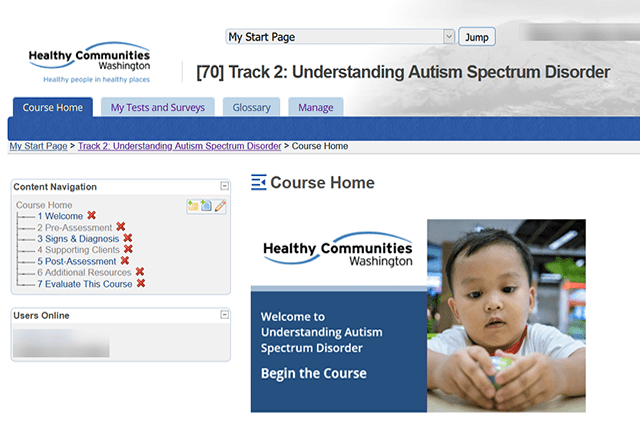Have you ever noticed that some classes have a set schedule where everyone meets at the same time, while others let you learn at your own pace? Those are actually different teaching methods called synchronous and asynchronous learning.
Both are great for helping people learn, but they each have their pros and cons. Knowing the difference can help you pick the best way to train people in your business.
What’s the difference between synchronous vs. asynchronous?
In synchronous learning, imagine a class where everyone shows up at the same time, like a traditional classroom. The instructor is there too, guiding the lesson live. This can happen in person or online, but the key is everyone’s learning together at the same pace.
Examples:
wp:list {“className”:””,”epStylingOptions”:{“columnsResponsiveEnabled”:false,”columnsHoverEnabled”:false,”itemsSpacingResponsiveEnabled”:false,”itemsSpacingHoverEnabled”:false,”listStyleResponsiveEnabled”:false,”listStyleHoverEnabled”:false,”listIconResponsiveEnabled”:false,”listIconHoverEnabled”:false,”columns”:{“target”:””,”responsive”:true,”hover”:true,”options”:[{“custom”:true,”control”:”ToggleOptions”},{“label”:”Columns”,”control”:”Range”,”attribute”:”columns”,”css”:”grid-template-columns”,”customValue”:”repeat({{value}}, 1fr)”,”props”:{“max”:5,”min”:1,”supportedUnits”:[]},”defaults”:{“desktop”:”1″},”show_if”:{“className”:[“ep-custom-list”]}}]},”itemsSpacing”:{“target”:””,”responsive”:true,”hover”:true,”options”:[{“label”:”Items Spacing”,”control”:”Range”,”attribute”:”itemsSpacing”,”css”:”grid-gap”,”props”:{“max”:100,”min”:0,”supportedUnits”:[“px”]},”show_if”:{“className”:[“ep-custom-list”]}}]},”listStyle”:{“target”:””,”responsive”:true,”hover”:true,”options”:[{“custom”:true,”control”:”IconClassToggle”,”condition“:{“relation”:”AND”,”query”:[{“field”:”attributes.className”,”compare”:”IN”,”value”:”ep-custom-list”}]}},{“label”:”Choose List Style”,”control”:”ButtonGroup”,”attribute”:”unorderListStyle”,”css”:”list-style-type”,”defaults”:{“desktop”:”disc”},”condition”:{“relation”:”AND”,”query”:[{“field”:”attributes.className”,”compare”:”IN”,”value”:”ep-custom-list”},{“field”:”attributes.ordered”,”compare”:”EQUAL”,”value”:false},{“field”:”attributes.className”,”compare”:”NOT IN”,”value”:”ep-custom-icon-list”}]},”props”:{“layout”:”stacked”,”options”:[{“customIcon”:”\u003csvg enable-background=’new 0 0 512 512′ version=’1.1′ viewBox=’0 0 512 512′ xml:space=’preserve’ xmlns=’http://www.w3.org/2000/svg’\u003e\u003cpath d=’m256 0c-141.16 0-256 114.84-256 256s114.84 256 256 256 256-114.84 256-256-114.84-256-256-256zm0 448c-105.86 0-192-86.135-192-192 0-40.406 12.25-78.604 35.542-111.2l267.66 267.66c-32.594 23.292-70.792 35.542-111.2 35.542zm156.46-80.802-267.66-267.66c32.594-23.292 70.792-35.542 111.2-35.542 105.86 0 192 86.135 192 192 0 40.406-12.25 78.604-35.542 111.2z’/\u003e\u003c/svg\u003e”,”value”:”none”},{“customIcon”:”\u003csvg enable-background=’new 0 0 29.107 29.107′ version=’1.1′ viewBox=’0 0 29.107 29.107′ xml:space=’preserve’ xmlns=’http://www.w3.org/2000/svg’\u003e\u003cpath d=’M14.554,0C6.561,0,0,6.562,0,14.552c0,7.996,6.561,14.555,14.554,14.555c7.996,0,14.553-6.559,14.553-14.555 C29.106,6.562,22.55,0,14.554,0z’/\u003e\u003c/svg\u003e”,”value”:”disc”},{“customIcon”:”\u003csvg enable-background=’new 0 0 341.333 341.333′ version=’1.1′ viewBox=’0 0 341.33 341.33′ xml:space=’preserve’ xmlns=’http://www.w3.org/2000/svg’\u003e\u003cpath d=’m170.67 0c-94.257 0-170.67 76.41-170.67 170.67s76.41 170.67 170.67 170.67 170.67-76.41 170.67-170.67-76.411-170.67-170.67-170.67zm0 298.67c-70.692 0-128-57.308-128-128s57.308-128 128-128 128 57.308 128 128-57.308 128-128 128z’/\u003e\u003c/svg\u003e”,”value”:”circle”},{“customIcon”:”\u003csvg enable-background=’new 0 0 60 60′ version=’1.1′ viewBox=’0 0 60 60′ xml:space=’preserve’ xmlns=’http://www.w3.org/2000/svg’\u003e\u003crect width=’60’ height=’60’/\u003e\u003c/svg\u003e”,”value”:”square”}]}},{“label”:”Choose List Style”,”control”:”ButtonGroup”,”attribute”:”orderListStyle”,”css”:”list-style-type”,”defaults”:{“desktop”:”decimal”},”condition”:{“relation”:”AND”,”query”:[{“field”:”attributes.className”,”compare”:”IN”,”value”:”ep-custom-list”},{“field”:”attributes.ordered”,”compare”:”EQUAL”,”value”:true},{“field”:”attributes.className”,”compare”:”NOT IN”,”value”:”ep-custom-icon-list”}]},”props”:{“layout”:”stacked”,”options”:[{“customIcon”:”\u003csvg enable-background=’new 0 0 512 512′ version=’1.1′ viewBox=’0 0 512 512′ xml:space=’preserve’ xmlns=’http://www.w3.org/2000/svg’\u003e\u003cpath d=’m256 0c-141.16 0-256 114.84-256 256s114.84 256 256 256 256-114.84 256-256-114.84-256-256-256zm0 448c-105.86 0-192-86.135-192-192 0-40.406 12.25-78.604 35.542-111.2l267.66 267.66c-32.594 23.292-70.792 35.542-111.2 35.542zm156.46-80.802-267.66-267.66c32.594-23.292 70.792-35.542 111.2-35.542 105.86 0 192 86.135 192 192 0 40.406-12.25 78.604-35.542 111.2z’/\u003e\u003c/svg\u003e”,”value”:”none”},{“customIcon”:”\u003csvg id=’Capa_1′ enable-background=’new 0 0 512 512′ viewBox=’0 0 512 512′ xmlns=’http://www.w3.org/2000/svg’\u003e\u003cg id=’_x31__1_’\u003e\u003cpath d=’m376 512v-512h-99.902l-3.56 9.932c-9.419 26.294-27.202 49.746-52.837 69.697-26.528 20.684-51.211 34.849-73.359 42.1l-10.342 3.383v114.771l19.702-6.519c36.387-12.012 69.448-29.268 98.672-51.445v330.081z’/\u003e\u003c/g\u003e\u003c/svg\u003e”,”value”:”decimal”},{“customIcon”:”Ⅰ”,”value”:”upper-roman”},{“customIcon”:”ⅰ”,”value”:”lower-roman”}]}}]},”listIcon”:{“target”:”li:before”,”includeDotSuffix”:false,”responsive”:true,”hover”:true,”hoverTarget”:”{{class}} li:hover:before”,”options”:[{“label”:”Icon”,”control”:”IconPicker”,”attribute”:”icon”,”defaults”:{“desktop”:”eplusicon-check”},”css”:”content”,”condition”:{“relation”:”AND”,”query”:[{“field”:”attributes.className”,”compare”:”IN”,”value”:”ep-custom-icon-list”}]}},{“label”:”Background”,”control”:”ColorPicker”,”attribute”:”iconBackground”,”css”:”background”,”condition”:{“query”:[{“field”:”attributes.className”,”compare”:”IN”,”value”:”ep-custom-icon-list”}]}},{“label”:”Color”,”control”:”ColorPicker”,”attribute”:”iconColor”,”css”:”color”,”condition”:{“query”:[{“field”:”attributes.className”,”compare”:”IN”,”value”:”ep-custom-icon-list”}]}},{“label”:”Size”,”control”:”Range”,”attribute”:”iconSize”,”css”:”font-size”,”props”:{“supportedUnits”:[“px”],”max”:100},”condition”:{“query”:[{“field”:”attributes.className”,”compare”:”IN”,”value”:”ep-custom-icon-list”}]}},{“label”:”Radius”,”control”:”Range”,”attribute”:”iconRadius”,”css”:”border-radius”,”condition”:{“query”:[{“field”:”attributes.className”,”compare”:”IN”,”value”:”ep-custom-icon-list”}]}},{“label”:”Padding”,”control”:”Range”,”attribute”:”iconPadding”,”css”:”padding”,”props”:{“supportedUnits”:[“px”],”max”:100},”condition”:{“query”:[{“field”:”attributes.className”,”compare”:”IN”,”value”:”ep-custom-icon-list”}]}}]},”savedStyling”:””,”clientId”:”c42b7681-912d-45cf-98b6-316b0da8adff”},”columns”:{“desktop”:{“value”:1,”important”:false,”unit”:””},”tablet”:{“value”:””,”important”:false,”unit”:”%”},”tabletModified”:false,”mobile”:{“value”:””,”important”:false,”unit”:”%”},”mobileModified”:false,”hover”:{“value”:””,”important”:false,”unit”:”%”},”hoverModified”:false},”itemsSpacing”:{“desktop”:{“value”:””,”important”:false,”unit”:”%”},”tablet”:{“value”:””,”important”:false,”unit”:”%”},”tabletModified”:false,”mobile”:{“value”:””,”important”:false,”unit”:”%”},”mobileModified”:false,”hover”:{“value”:””,”important”:false,”unit”:”%”},”hoverModified”:false},”unorderListStyle”:{“desktop”:”disc”,”tablet”:””,”tabletModified”:false,”mobile”:””,”mobileModified”:false,”hover”:””,”hoverModified”:false},”orderListStyle”:{“desktop”:”decimal”,”tablet”:””,”tabletModified”:false,”mobile”:””,”mobileModified”:false,”hover”:””,”hoverModified”:false},”icon”:{“desktop”:{“icon”:”eplusicon-check”},”tablet”:{“icon”:””},”tabletModified”:false,”mobile”:{“icon”:””},”mobileModified”:false,”hover”:{“icon”:””},”hoverModified”:false},”iconBackground”:{“desktop”:{“color”:””},”tablet”:{“color”:””},”tabletModified”:false,”mobile”:{“color”:””},”mobileModified”:false,”hover”:{“color”:””},”hoverModified”:false},”iconColor”:{“desktop”:{“color”:””},”tablet”:{“color”:””},”tabletModified”:false,”mobile”:{“color”:””},”mobileModified”:false,”hover”:{“color”:””},”hoverModified”:false},”iconSize”:{“desktop”:{“value”:””,”important”:false,”unit”:”%”},”tablet”:{“value”:””,”important”:false,”unit”:”%”},”tabletModified”:false,”mobile”:{“value”:””,”important”:false,”unit”:”%”},”mobileModified”:false,”hover”:{“value”:””,”important”:false,”unit”:”%”},”hoverModified”:false},”iconRadius”:{“desktop”:{“value”:””,”important”:false,”unit”:”%”},”tablet”:{“value”:””,”important”:false,”unit”:”%”},”tabletModified”:false,”mobile”:{“value”:””,”important”:false,”unit”:”%”},”mobileModified”:false,”hover”:{“value”:””,”important”:false,”unit”:”%”},”hoverModified”:false},”iconPadding”:{“desktop”:{“value”:””,”important”:false,”unit”:”%”},”tablet”:{“value”:””,”important”:false,”unit”:”%”},”tabletModified”:false,”mobile”:{“value”:””,”important”:false,”unit”:”%”},”mobileModified”:false,”hover”:{“value”:””,”important”:false,”unit”:”%”},”hoverModified”:false},”epAnimationGeneratedClass”:”edplus_anim-dSOTuk”,”epGeneratedClass”:”eplus-wrapper”}- Webinar
- Live discussions or chat
- Live online classrooms
- Meetings
- Presentations
Asynchronous learning is more like self-study. Sure, there are deadlines to keep you on track, but you learn at your own speed. You might watch pre-recorded lessons whenever you want, instead of attending a set class time. Instructors might be available to answer questions, but not in real-time like a synchronous class. Think of it like emailing your teacher for help, instead of raising your hand in class.
Examples:
- College courses
- Self-paced courses
- Instructor-led classrooms
- Bulleting boards or discussion forums
- Communities of practice
Synchronous Learning: Good and Not-So-Good
Synchronous learning, where everyone learns together at the same time, has some definite perks for organizations like yours. Here’s why they might choose it:
Keeps students engaged: It’s easier to participate and stay focused when everyone’s learning together.
Provides structure: The set schedule and clear path through the material help students stay on track.
Reduces chances of falling behind: The instructor can keep an eye on everyone’s progress and offer help if needed.
Boosts teamwork: Working and discussing things with classmates can make learning more fun and effective.
Improves understanding: Students can ask questions right away and get immediate answers from the instructor.
However, there’s a flip side to synchronous learning:
Strict schedule can be tough: Not everyone has the same availability, and a fixed schedule might be hard for some to manage.
All or nothing: If you miss a class, you miss out on the live instruction and discussions. Catching up can be difficult.
Not for everyone’s learning style: The set pace and structure might not work well for students who learn best at their own speed or prefer a more hands-on approach.
Picking the Perfect Training for Your Business: Sync vs. Async

Both synchronous and asynchronous learning are great for training, but which one works best for your business? Here’s a breakdown to help you decide:
Consider the Time Crunch
Short on time? Synchronous learning might be your best bet. Everyone learns the same thing at the same time, so you know your employees are all on the same page quickly.
Employees have crazy schedules? Asynchronous learning is your friend! They can squeeze training in whenever they have a free moment. This is perfect for businesses where getting everyone together for training is a nightmare.
Is the training complex?
Go synchronous: For tricky subjects where learners might have lots of questions, a live instructor is a huge help. They can guide students through the material and answer questions on the spot.
Go asynchronous: If it’s pretty straightforward, and learners can grasp the information easily, asynchronous lets them learn at their own pace.
Cost Considerations
Big difference in cost: Synchronous learning often needs a teacher to lead the course, which can add up.
Can you afford a trainer? Do you have someone on staff who can teach it? Factor in these costs when picking your training method.
Overall Goals
Beyond just learning the material, what are your bigger goals for training?
Are they to boost teamwork? Synchronous learning might be the way to go. Working together in a live session can be great for building collaboration among colleagues and even different departments.
Are they to focus on completion rates? If getting everyone through the training is your main concern, asynchronous learning can be efficient. Employees can learn at their own pace, fitting it in around their schedules.
Managing employee training can be challenging. Synchronous learning offers live instruction but requires scheduling, while asynchronous learning provides flexibility but might lack interaction.
Learning Management System Is a Solution
A learning management system (LMS) can be a powerful solution. It offers both synchronous and asynchronous learning experiences in one convenient platform. Here’s how an LMS can benefit your training:
- Streamlined Training: Create and deliver courses, track progress, and manage assessments – all within a single system.
- Engaging Learning: Utilize features like interactive videos, quizzes, and presentations to make learning more engaging and effective.
- Improved Completion Rates: Tracking tools and reminders help employees stay on track and motivated to finish their training.
- Reduced Costs: An LMS can save time and resources compared to traditional training methods.
By simplifying the training process and boosting engagement, an LMS can contribute to a more skilled and satisfied workforce.



